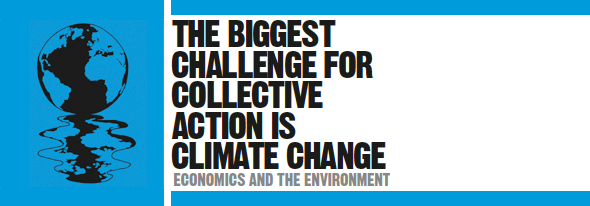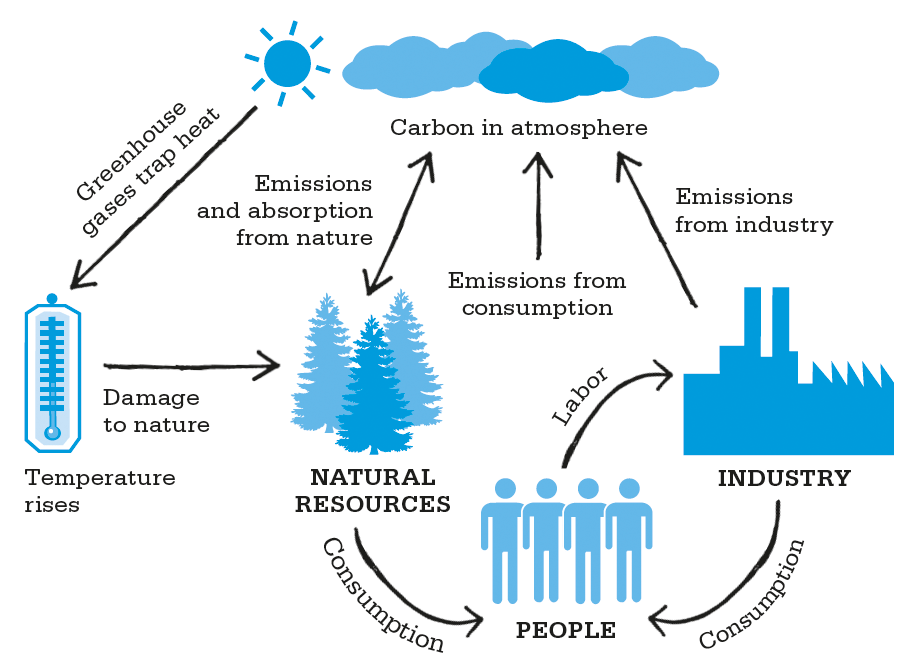

Economic policy
William Nordhaus (1941–)
Nicholas Stern (1946–)
1896 Swedish scientist Svante Arrhenius predicts a doubling of atmospheric carbon dioxide will produce a 9–11°F rise in global surface temperature.
1920 British economist Arthur Pigou proposes levying taxes on pollution.
1992 The United Nations Framework Convention on Climate Change is signed.
1997 The Kyoto Protocol is ratified; by 2011 more than 190 countries sign up to it.
2011 Canada retracts from the Kyoto Protocol.
Economic development and prosperity since the Industrial Revolution have come about through technology, largely driven by fuels such as coal, oil, and gas. It is increasingly clear, however, that this prosperity comes at a cost—not only are we fast depleting these natural resources, but burning fossil fuels pollutes the atmosphere. A growing body of evidence points to emissions of greenhouse gases, in particular carbon dioxide (CO2), as a cause of global warming, and the consensus now among scientists worldwide is that we risk devastating climate change unless emissions are cut quickly and drastically.

The implications are as much economic as environmental, but both economists and governments are divided on the measures that should be taken. Until recently, many have argued that the costs of combating climate change are more damaging to economic prosperity than the potential benefits. Some continue to dispute the evidence that climate change is human-made, while others argue that global warming could even be beneficial. A growing number now accept that the issue is one that must be addressed, and economic solutions have to be found.

The Industrial Revolution that began about 150 years ago has led to countries burning large amounts of fossil fuels. These emissions create a “greenhouse effect” in the atmosphere.
In 1982, US economist William Nordhaus published How Fast Should We Graze the Global Commons?, looking in detail at the economic impact of climate change and possible solutions. He pointed out that certain features of the climate problem make it unique in terms of finding economic solutions: the long time scale, the uncertainties involved, the international scope of the problem, and the uneven distribution of benefits and costs across the globe.
"Price-type approaches like harmonized taxes on carbon are powerful tools for coordinating policies and slowing global warming."
William Nordhaus
In 2006, the UK government commissioned a report by British economist Nicholas Stern on the economics of climate change. The Stern Review was unequivocal in its findings; it presented sound economic arguments in favor of immediate action to reduce greenhouse gas emissions. Stern estimated that the eventual cost of climate change could be as much as 20 percent of GDP (gross domestic product, or total national income), compared with a cost of around 1 percent of GDP to tackle the problem if action was taken promptly. In 2009, Nordhaus estimated that without intervention, economic damages from climate change would be around 2.5 percent of world output per year by 2099. The highest damages would be sustained by low-income tropical regions, such as tropical Africa and India.
The question was no longer whether we could afford to cut emissions, but whether we could afford not to, and how this could best be achieved. There are strong arguments for government intervention: the atmosphere can be considered in economic terms as a public good, which tends to be undersupplied by markets; pollution can be seen as an externality, where the social costs of an action are not reflected in prices and so are not fully borne by the person taking it. For these reasons Stern described climate change as the greatest market failure ever experienced.

William Nordhaus devised a computer program called DICE to show how the elements of climate change interact, and where the ecological and financial costs lie. This financial modeling system allows governments to factor in their current consumption, resources, and needs, and weigh up the costs and benefits—to them and the Earth—of the choices available.
The first hurdle for economists such as Nordhaus and Stern was to convince governments to introduce measures that would be harmful to their economies in the short run but would mitigate more damaging consequences in the long run. The second was to find the most efficient way of enforcing an emissions policy. Not all governments were easily persuaded. The more developed economies, which are mainly in temperate areas, are not likely to suffer the worst consequences of a rise in global temperatures. The likely changes in climate will hit poorer countries much harder. This means that, in many cases, the countries with the greatest incentive to mitigate the effects of climate change are those that are producing the least pollution.
The worst polluters, such as the US, Europe, and Australia, have been reluctant to accept that governments should impose expensive policies. Even if they did, the pollution is not restricted to their land masses. The problem is global and demands collective action on a global scale.
The need for collective action was first noted at a U.N. “Earth Summit” in 1992, which called for all its members to curb their emissions of greenhouse gases. Many governments have developed environmental policies and strategies for implementing those policies. Regulation in the form of punishments, such as fines for excessive production of pollutants, is one solution, but it is difficult to set emissions quotas that are fair to all businesses concerned. The fines are also difficult to enforce.
Another option, which was first suggested by British economist Arthur Pigou in 1920, is the imposition of taxes on pollution. Levying taxes on firms that emit greenhouse gases, and on energy suppliers and producers for the amount of carbon they release into the atmosphere, would act as a disincentive to pollute. Taxes on fossil fuels would discourage their excessive consumption. Pigou’s idea is to make individuals face the full social costs of their actions, to “internalize” the externality.
Pollution can be viewed as a market failure because normally there is no market for it. Economists suggest that if there was, the socially optimal amount of pollution would be emitted because polluters would face the full costs of their actions. Therefore, another proposed solution to the climate problem is to create a market for pollution through emissions trading. This involves a government (or, in some cases, a number of governments working together) determining an acceptable level of, for example, CO2 emissions, and then auctioning permits to firms whose business involves the discharge of carbon dioxide. The permits are tradable, so if a firm needs to increase its emissions, it can buy permits from another that has not used its quota. This kind of plan has the advantage of rewarding the firms who cut their emissions and can then sell their surplus permits. It can discourage firms from exceeding their quotas and having to buy extra permits. However, the total amount of emissions remains the same and is controlled by a central authority.

Hurricane Katrina destroyed much of New Orleans in 2005. The cost of the damage, estimated at $81 billion, focused worldwide attention on the economic effects of climate change.
While emissions trading programs are certainly a step in the right direction, the problem needs to be tackled globally to avert the risk of climate change. However, international agreements such as the Kyoto Protocol have failed to achieve universal ratification. In 1997, 141 countries took part in discussions, but by 2012 only 37 countries had agreed to implement its targets for greenhouse gas emissions. The US has consistently rejected the terms of the agreement, and Canada pulled out in 2011. Even those countries that pledged to curb their emissions have often failed to meet their reduction targets. Developed countries such as the US and Australia argue that it would be too harmful to their economies; developing economies such as China, India, and Brazil argue that they should not have to pay for the pollution caused by the West (even though they themselves are fast becoming major polluters). On the other hand more eco-advanced nations, such as Germany and Denmark, agreed to reduction targets of more than 20 percent.
Economists have devised various models for studying the economic impact of climate change, such as Nordhaus’s Dynamic Integrated model of Climate and the Economy (DICE), first presented in 1992. This links together CO2 emissions, the carbon cycles, climate change, climatic damages, and factors affecting growth.
Most economists now agree that climate change is a complex problem with the potential to cause serious long-term damage. The solution is far from obvious, but in 2007, Nordhaus said that he believed the secret to success lies not in large, ambitious projects, such as Kyoto, but in “universal, predictable, and boring” ideas, such as carbon taxes.

Solar panels capture sunlight in the Himalayas in northern India. Solar power may be an efficient source of renewable energy in India, where sunshine is intense.
India’s growth rate for 2012 was predicted to be 7–8 percent for the year. The country’s business leaders are aware that if this rate of growth continues, there will be a huge energy shortage. The fear is that the shortfall will be met by the use of low-cost “dirty” coal and diesel fuel, so efforts are being made to increase efficiency while also encouraging the use of renewable energy products, using solar, wind, and geothermal technologies.
Economists hope that renewable energy forms, together with nuclear energy (judged to be a “clean” energy provider) can combine to meet all of India’s growing needs. However, so far the renewable energy forms, such as solar, are not commercially viable industries on a large scale. This means that they will need a short-term boost from state subsidies to expand. This is provided for in India’s ambitious National Action Plan on Climate Change, introduced in June, 2008.